IEEE Smart Cities Publications Journals and Magazines Special Issues
This web page displays the effort of IEEE Smart Cities Publications Committee in proposing and guest editing special issues for IEEE Journals and Magazines which is of interests to IEEE Smart Cities Community.
Call for Papers
2024
Healthcare Information Systems for Disease Monitoring and Management in Smart Cities, IEEE Journal of Biomedical and Health Informatics, deadline 29th Feb 2024.
Technology Management in Smart Cities Infrastructure and Applications, IEEE Engineering Management Review, deadline 15th Feb 2024.
Security and Privacy in Consumer Electronics for Smart Cities, IEEE Consumer Electronics Magazine, deadline 1st March 2024
Published Special Issues
2023
Special Section on Smart Home Energy Management based on Consumer Electronics, in IEEE Transactions on Consumer Electronics
- Editorial Link: TBC
2022
Special Issue on Recent Trends on Sustainable Smart Cities: Proceedings of IEEE ISC2 2022, in Sustainable Cities and Society,
- Editorial Link: https://www.sciencedirect.com/
journal/sustainable-cities- and-society/special-issue/ 109RFW3MHX0
Special Issue on Smart Cities and Smart Villages: Clean Energy Generation, in IEEE Power and Energy Magazine
- Editorial Link: https://ieeexplore.ieee.org/
document/9863784
Special Issue on Smart Cities Based on the Efforts of the Systems, Man, and Cybernetics Society, in IEEE Transactions on Systems, Man and Cybernetics: Systems
- Editorial Link: https://ieeexplore.ieee.org/
document/9653765
2021
Special Issue on Smart Buildings for Smart Cities, in IEEE Transactions on Industry Applications
- Editorial Link: https://ieeexplore.ieee.org/
document/9956771
IEEE Smart Cities Publications Journals and Magazines Special Issues
This web page displays the effort of IEEE Smart Cities Publications Committee in proposing and guest editing special issues for IEEE Journals and Magazines which is of interests to IEEE Smart Cities Community. Please click here to view.
Past Issues
2022
April 2022 – Knowledge-Based Economy in Smart Cities
March 2022 – Smart Energy Systems for Smart Cities
February 2022 – Empowering Energy Citizens and Energy Communities for Smart Cities, Part 2
January 2022 – Empowering Energy Citizens and Energy Communities for Smart Cities, Part 1
2021
December 2021 - Highlights of IEEE International Smart Cities Conference 2021 (IEEE ISC2)
November 2021 - Smart Transportation
October 2021 - Special Issue on Smart Transportation
September 2021 - General Issue
August 2021 - General Issue
July 2021 - General Issue
June 2021 - Explainable Artificial Intelligence for Smart Cities
May 2021 - Highlights of IEEE International Smart Cities Conference 2020 (IEEE ISC2)

Managing Editor

Assistant Managing Editor
IEEE Smart Cities Publications Editorial Board
Luis M. Fernandez-Ramirez
Bernard Fong
Sergii Kushch
Prasad Enjeti
Rabie Ramadan
Ramkumar Lakshminarayanan
Francesco Flammini
Fateh Krim
Maria Pia Fanti
Kristina Kunert
Vladimir Orlic
Asif Ali Ahmed R
Werbeston Oliveira
Emilio Ghiani
Shafi Khadem
Nikumani Choudhury
Mohammad Zeyad
S.M. Masum Ahmed
Payman Dehghanian
Sona N Thadevus
Kumaresan Natarajan
Lues Felipe Gaitan Cubides
Chao Shen
Balaji Sankarshanan
Chun Sing Lai
Zhang Wei
Shashikant Patil
Sai Munikoti
Akhil Jabbar Meerja
Click here for more info
Loi Lei Lai
Editor-in-Chief
IEEE Smart Cities eNewsletter
Coordination of Storage Systems to reduce the Impact of high Penetration of Solar Energy in Distribution Network
Dongxiao Wang, Australian Energy Market Operator, Australia
Introduction
Smart grids and cities are about anticipating situations, with an efficient forecast of weather conditions (for example solar energy prediction) and the possibility of making decisions in almost real-time [1]-[4]. With high penetration of variable renewable sources and the lack of anticipatory capabilities will result in uneconomic choices (such as severe the curtailment of generation) or lack of resilience when facing faults and disturbances [5-6]. However, as an effective solution to a future energy crisis, renewable energy resources are playing a vital role in current power systems. Based on the electricity forecast of International Energy Agency (IEA), the share of renewable energy in meeting global power demand would reach almost 30% in 2023, up from 24% in 2017 [7]. During this period, more than 70% of global electricity generation growth is met by renewables, led by solar PV. The large-scale penetration of PV energy in the distribution network causes many power quality issues as well, such as harmonic pollution and voltage problem. Overvoltage problem usually occurs at the time of high PV penetration periods and light load periods while undervoltage happens at the time of low PV penetration periods and heavy load periods. Although the energy storage cost has dropped, customers still bear a financial burden on installing large energy storage systems [8].
Except for voltage regulation, loading management is another important issue in distribution network due to the increasing energy-hungry appliances [9]. Especially in recent years, air conditioners are rapidly making the way to households because of summer heat and falling upfront cost. In line with an investigation led by Ausgrid [10], air conditioners contribute more than half of the load in some of their substations in summer days. If such demand comes up to a certain ratio of feeder load, challenges would be imposed on system operation. Network infrastructure capacity needs to be upgraded by the system operator to maintain reliable electricity supply. Consequently, billions of dollars would be spent on network upgrading to deal with the short but sharp peak load period. Nevertheless, infrastructure upgrading is only used for short periods of the year to meet peak demand, which is not cost-effective for system operators.
How to address the noted issues (i.e. voltage regulation and loading management) in a technically and economically efficient manner needs to be considered by the researchers. With the popularity of demand response (DR) technologies, an alternative way to address peak load is through DR programs by shaping the load curve for optimal use of energy and improving asset investment overall efficiency [11,12]. The pressure on integrating large-scale PV resources into distribution network can be alleviated as well with the help of DR programs. Owing to rapid progress in control and communication techniques, thermostatically controlled loads (TCLs) in the end-user side can be equipped with control modules to be better involved in DR programs. Among various types of TCLs, air conditioners receive researchers’ increasing attention because they have relatively fast response time with least end-user disruptions and mainly contribute to the summer peak load. When air conditioners are turned on/off, the room temperature can maintain within a certain range by storing a large amount of heat/cold air. This phenomenon is referred to as thermal inertia, which is defined as a thermal mass is capable of resisting the change on its temperature faced with the fluctuation of ambient temperature[13]. Consequently, a household can shift its energy consumption over the planning horizon to help consume the peak PV generation amount or reduce the peak load periods. The thermal buffering capacity in an air-conditioned household can imitate the energy buffering characteristics of physical energy storage systems, such as batteries, and hence can be viewed as virtual energy storage systems (VESSs). Meng et al. coordinated DR from the domestic refrigerator to form the VESS, aiming to provide frequency service for the system. Distribution utilities are encountering new opportunities in the situation of a growing number of air conditioners and increasing penetration of PV resources at customer side. By coordinating VESSs, network voltage regulation and overloading issues can be solved in an efficient and economical way.
References
- J. Baillieul et al., “Control challenges in microgrids and the role of energy-efficient buildings,” Proceedings of the IEEE, vol. 104, no. 4, pp. 692-696, Apr. 2016.
- M. Masera, et al. ''Smart (electricity) grids for smart cities: Assessing roles and societal Impacts,'' Proceedings of the IEEE, vol. 106, no. 4, pp. 613-625, April 2018.
- C. S. Lai, et al., ''A comprehensive review on large-scale photovoltaic system with applications of electrical energy storage,'' Renewable and Sustainable Energy Reviews, vol. 78, pp. 439-451, 2017.
- C. Huang, et al., ''Data-driven short-term solar irradiance forecasting based on information of neighboring sites,'' IEEE Transactions on Industrial Electronics, vol. 66, no.12, pp. 9918-9927, 2018.
- Y. F. Wang, et al., “Resilience-constrained hourly unit commitment in electricity grids,” IEEE Transactions on Power Systems, Vol. 33, No. 5, pp. 5604-5614, Sep. 2018.
- Y. F. Wang, et al., “Impact of cascading and common cause outages on resilience-constrained economic operation of power systems in extreme conditions,” IEEE Transactions on Smart Grid, DOI: 10.1109/TSG.2019.2926241, 1 July 2019
- International Energy Agency, “Renewables 2018”, [Online] Available: https://www.iea.org/renewables2018/ (Accessed13/11/2019)
- C. S. Lai and M. D. McCulloch, “Levelized cost of electricity for solar photovoltaic and electrical energy storage,” Applied Energy, vol. 190, pp. 191–203, March 2017.
- D. Wang et al., “Coordinated dispatch of networked energy storage systems for loading management in active distribution networks”, IET Renewable Power Generation, vol. 10, no. 9, pp. 1374-1381, Oct. 2016.
- R. Smith, et al., “Demand response: A strategy to address residential air-conditioning peak load in Australia,” J. Mod. Power Syst. Clean Energy, vol. 1, no. 3, pp. 223-230, Nov. 2013
- F. Y. Xu, et al., “Shifting boundary for price-based residential demand response and applications,” Applied Energy, Elsevier, 146, pp. 353–370, 2015.
- C. S. Lai, et al., “Application of distributed intelligence to industrial demand response,” Chen-Ching Liu, Stephen McArthur and Seung-Jae Lee (Editors), Smart Grid Handbook, IEEE Press & Wiley, 2016.
- D. Wang, et al., “Optimal air-conditioning load control in distribution network with intermittent renewables”, J. Mod. Power Syst. Clean Energy, vol. 5, no. 1, pp. 55-65, Jan. 2017.
Author
Dongxiao Wang (M’18) received the B.Eng. degree in thermal energy and power engineering from North China Electric Power University, Beijing, China, and the Ph.D. degree in electrical engineering from University of Newcastle, Australia, in 2014 and 2018. He is current a forecasting analyst in Australia Energy Market Operator, Australia. His research interest includes demand side management, the utilization of thermostatically controlled loads, energy storage systems, and renewable energy integration.
18 March 2020
IEEE - Techno-economic Metrics for Hybrid Energy & Storage Systems
IEEE P2814 Techno-economic Terminology Working Group (Chair: Dr Chun Sing Lai, Brunel University London, UK; Vice-Chair: Dr Dongxiao Wang, Australia Energy Market Operator, Australia; Secretary: Mr Michael Sanders, Salt River Project, USA)
Energy infrastructures play a critical role in smart cities by providing power to services and activities. Low carbon power generation replaces fossil fuel power generation to decarbonize society. The future of smart cities will highly rely on renewables such as solar and wind [1]. However, the high penetration of this clean energy could introduce power system stability issues. With limited controllability of power generation from renewables, Energy Storage (ES) is a technology to store and deliver power to the grid with controllability. Inevitably, ES will play a crucial role in decarbonizing the whole energy system including electricity, heat and gas networks for smart cities implementation.
A technical standard is a requirement or established norm for a repeatable technical task including in smart cities. The standard is usually a formal document that creates uniform technical or engineering requirement, methods, processes, and practices. Several technical standards are in development for sustainable energy technologies including fuel cells, photovoltaics, dispersed generation, and ES [2]. Standards are created through standard development. Standard development certifies that services and products perform as intended. They also support interoperability, installation and testing techniques, protect users and their environment, and enhance the quality of life of limitless communities and individuals globally [3]. IEEE standards are classified as follows [4]:
- Standards: documents with mandatory requirements.
- Recommended practices: documents in which procedures and positions preferred by the IEEE are presented.
- Guides: documents in which alternative approaches to good practice are suggested but no clear-cut recommendations are made.
- Trial-Use documents: publications in effect for not more than three years. They can be any of the categories of standards publications listed above.
There are standards for smart cities related to solar but there is no mention on the energy storage [5]. In this newsletter, the development of a new recommended practices on techno-economics for energy storage and low carbon power generation will be introduced.
Energy storage may enhance power system stability. Medical equipment, electric transportation, and communication network cannot be in operation without reliable energy sources. Due to the reduced cost and technical maturity, there is a sharp increase in the number of novel ES technologies developed including redox flow battery, supercapacitors, underwater compressed air ES, and pumped heat ES [6]–[8]). Fig. 1 presents a simple comparison between the energy infrastructure in the past mainly powered by fossil fuel generation and the infrastructure for smart cities.
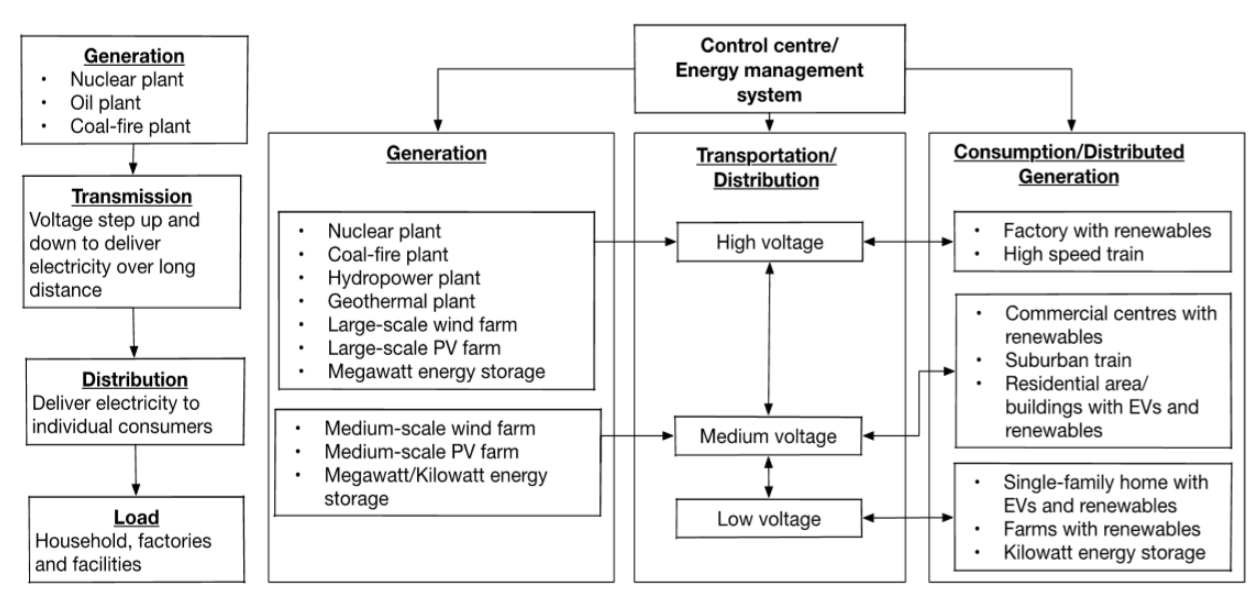
Fig. 1: Comparison between the energy infrastructure (left) in the past (right) for smart cities.
In particular, some of the key challenges should be considered when deploying ES as follows:
Technical
- Grid services: ES provides several grid services including black start, frequency support, and load shifting.
- System topologies: ES applies to a range of systems including off-grid, grid-connected, transmission system, and distribution system [9].
- Whole energy system or multi-vector energy system: For countries including the UK and Finland, heat energy constitutes a large proportion of energy consumption. Whole energy system focuses on the study of integrating various energy types (heat, gas, and electricity) to optimally meet the load demand. The choice of ES for the system affects the technical performance.
- System resilience: There are numerous definitions of system resilience for the smart grid. In general, it is defined as the ability for the grid to recover following a low-probability and high-impact event [10]. ES can be used to improve system resilience by providing energy to the affected area of the grid.
- Generation integrated ES: Conversion to electricity from primary energy (e.g. heat) has been the norm for ES. This may not be the optimal approach for storing MWh of energy considering the inefficiency and expense of transforming primary energy into electricity, then into an intermediate form, and later back to electricity. Therefore, generation-integrated ES systems are a novel class of system for storing energy at some point along the transformation between the primary energy form and electricity [11].
Economic
- Business value: ES delivers business value when used for grid services. ES generates revenue and creates savings. For example, in the UK Short Term Operating Reserve and Fast Reserve are energy services procured by the National Grid [12].
- Technological difference: The ability to capture the technical differences between ES technologies and apply to economic appraisal is difficult. For a fair comparison of ES options, this is a key challenge that needs to be addressed. For example, the degradation of battery has been a key consideration for the battery’s economic [13].
By acknowledging the above key challenges, IEEE P2814 standard fills a critical gap in the current energy sector landscape by developing a techno-economic appraisal framework to compare different ES technologies considering various energy generation and service scenarios. The Project Authorization Request was submitted on 14th Feb. 2019, approved on 21st May 2019, and with an expiration date on 31st Dec. 2023. Currently, the scope and purpose of the standard are as follows:
Scope
This standard defines techno-economic terminologies used in the development, construction, and operation of renewable energy and electrical energy storage systems.
Purpose
- There is no consistent definition of techno-economic terms that have arisen in the evolution of renewable energy and ES systems.
- There is a need to define techno-economic terminology so that stakeholders can use a common language when planning standards and for understanding published industrial and technical reports.
- This standard is intended to serve as a basic reference for policymakers, developers, and users of such systems, for planning industry standards, and the interpretation of published technical and industrial reports.
- The envisioned stakeholders for the Standard include financers, engineers, policy-makers, entrepreneurs, academics, researchers and general interest in energy systems and ES systems. As of March 2020, the standard has about 20 active members from industries and academic institutions, from worldwide including the USA, UK, Australia, and China. There were four meetings held to date.
In conclusion, this newsletter reports a new standard is currently under development to address the techno-economic appraisal challenge for energy storage and low carbon power generation systems. Please email the Standard Chair: Dr Chun Sing Lai (c.s.lai@brunel.ac.uk) for more information. The development of the standard can be found on this website (https://sagroups.ieee.org/2814/). All are welcome to join the working group.
Acknolwedgement
This work is contributed by P2814 Working Group and its members. The authors would like to thank the support from IEEE Standards Association (SA), in particular for Ms Christy Bahn, IEEE SA Program Manager, and Professor Loi Lei Lai, IEEE Systems, Man and Cybernetics Society Standards Committee Chair for their support.
This document solely represents the views of IEEE P2814 WG and does not necessarily represent a position of either the IEEE or the IEEE Standards Association.
References
-
I. Lloyd, “How to power smart cities in a clean, low-carbon future,” 2019. [Online]. Available: https://www.smartcitiesworld.net/opinions/opinions/how-to-power-smart-cities-in-a-clean-low-carbon-future.
-
“IEEE SCC21 Standards Coordinating Committee on Fuel Cells, Photovoltaics, Dispersed Generation, and Energy Storage.” [Online]. Available: http://grouper.ieee.org/groups/scc21/index.html.
-
“IEEE Standards Used in Your Everyday Life.” [Online]. Available: https://beyondstandards.ieee.org/networking/ieee-standards-used-in-your-everyday-life/%0D.
-
“IEEE SA Standards Board Operations Manual,” IEEE Standards Association. [Online]. Available: https://standards.ieee.org/about/policies/opman/sect1.html.
-
K. van Dam, “Mapping Smart City Standards,” Imperial Consultants. [Online]. Available: https://www.bsigroup.com/LocalFiles/en-GB/smart-cities/resources/BSI-smart-cities-report-Mapping-Smart-City-Standards-UK-EN.pdf.
-
C. S. Lai and M. D. McCulloch, “Levelized cost of electricity for solar photovoltaic and electrical energy storage,” Appl. Energy, vol. 190, 2017, doi: 10.1016/j.apenergy.2016.12.153.
-
A. J. Pimm, S. D. Garvey, and M. de Jong, “Design and testing of energy bags for underwater compressed air energy storage,” Energy, vol. 66, pp. 496–508, 2014.
-
A. Smallbone, V. Jülch, R. Wardle, and A. P. Roskilly, “Levelised Cost of Storage for Pumped Heat Energy Storage in comparison with other energy storage technologies,” Energy Convers. Manag., vol. 152, pp. 221–228, 2017.
-
C. S. Lai and M. D. McCulloch, “Sizing of Stand-Alone Solar PV and Storage System with Anaerobic Digestion Biogas Power Plants,” IEEE Trans. Ind. Electron., vol. 64, no. 3, 2017, doi: 10.1109/TIE.2016.2625781.
-
L. Huang et al., “Resilience-Constrained Economic Dispatch for Blackout Prevention,” IFAC-PapersOnLine, 2018, doi: 10.1016/j.ifacol.2018.11.744.
-
S. D. Garvey et al., “On generation-integrated energy storage,” Energy Policy, vol. 86, pp. 544–551, 2015.
-
G. Locatelli, D. C. Invernizzi, and M. Mancini, “Investment and risk appraisal in energy storage systems: A real options approach,” Energy, vol. 104, pp. 114–131, 2016.
-
C. S. Lai et al., “Levelized cost of electricity for photovoltaic/biogas power plant hybrid system with electrical energy storage degradation costs,” Energy Convers. Manag., vol. 153, 2017, doi: 10.1016/j.enconman.2017.09.076.
Authors
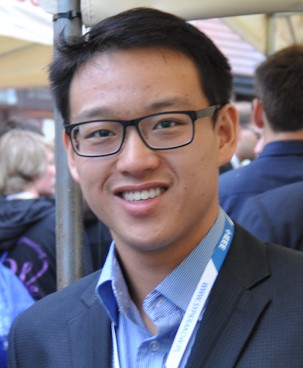 |
Chun Sing Lai (S’11, M’19, SM’20) received the BEng (First Class Honours) in electrical and electronic engineering from Brunel University London, UK and DPhil in engineering science from the University of Oxford, UK in 2013 and 2019, respectively. Dr Lai is currently a Lecturer at Department of Electronic and Computer Engineering, Brunel University London, UK and also a Visiting Academic with the Department of Electrical Engineering, Guangdong University of Technology, China. He is a member of Brunel Institute of Power Systems. From 2018 to 2020, he was an Engineering and Physical Sciences Research Council Research Fellow with the School of Civil Engineering, University of Leeds. He is Secretary of the IEEE Smart Cities Publications Committee and Acting EiC of IEEE Smart Cities Newsletters. He organized the workshop on Smart Grid and Smart City, IEEE SMC 2017 in Canada. Dr Lai is the Working Group Chair for IEEE P2814 Techno-economic Metrics Standard for Hybrid Energy and Storage Systems. His current research interests are in power system optimization, energy system modelling, data analytics, and energy economics for low carbon energy networks and energy storage systems. |
 |
|
 |
|
28 June 2020
Non-Standard Chinese Building Address Standardization in Smart City
Xue-feng Xi, Bao-chuan Fu and Victor S. Sheng
Abstract: Due to the large number of non-standard building addresses and the semantic ambiguity of addresses expressed in Chinese natural language, traditional methods based on string matching are difficult to meet requirements. To address these problems, we propose an innovative joint learning approach based on the hash map principle and the word frequency theory for standardizing Chinese non-standard building addresses. Our experimental results on a real-world dataset constructed via the crowdsourcing technology show that our approach has an outstanding accuracy and the adaptability for utilizing data from different sources.
1. Introduction
Unique building address representation is critical to a smart city [1, 2]. Different from other countries, Chinese building addresses do not have a strict uniform format. Moreover, there are various address sources, such as different user registration addresses at different companies (e.g., utilities such as water companies and gas companies) and different registration addresses at the public security personnel. This leads to different representations of a building address in China. Lack of unique building address representation results in a series of problems, e.g., the inability of the information from different sources to be connected, related services not being able to be displayed on the map, and the incomplete integration of different data resources. To solve these problems, we propose a feasible method to construct a standardized address database and then map other addresses into the standard address uniformly.
2. Problem Statement
We define the problem of non-standard Chinese building address standardization as follows.
Let us use X = {x1, x2, ……, xn} to denote a non-standard Chinese building address dataset and Y = {y1, y2, ……, ym} to denote the standard address dataset. The aim of non-standard Chinese building address standardization is to find a mapping function f satisfied the equality Y = f(X).


Fig1: An Example of Address Mapping.
However, there are two key challenges in this task: (I) Due to the large amount of data, the method of manual retrieval in more than 900,000 pieces of data is time-consuming and labor-consuming. Therefore, manual retrieval is not feasible. (II) Because of the semantic similarity between address strings, traditional string matching retrieval methods cannot be used in this problem.
3. Our Model
Some existing methods, such as tree structure [3] and fish structure [4], partially solve the above problems. However, these methods do not perform well and the computation cost is high due to their complexity [5].
Inspired by these methods, we propose a joint learning approach for standardizing Chinese non-standard building addresses, which automatically implements matches between non-standard addresses and standard addresses based on the theory of hash mapping and word frequency.
The implementation of address matching uses a non-standard address as an input and outputs a set of standard addresses in descending order in terms of similarity. Non-standard address automatic matching mainly includes three major steps: (i) build standard address dictionary (Step A); (ii) reformat each non-standard building address (Step B); (iii) match non-standard addresses (Step C). The architecture diagram is shown in Fig. 2.


Fig2: The Architecture of Our Non-standard Chinese Building Address Standardization Model.
4. Discussions
Firstly, we proposed a standard address modelling via a hash standard address dictionary. The standard address can be used to create a dictionary file that can be quickly found. The main structure is a hash structure, which is used for subsequent non-standard address matching steps. Secondly, the address panning procedure is used to reduce the space for the candidate set of a standard address. Finally, non-standard address match is achieved. For an input non-standard address, the matching standard address is found in the candidates of the standard address dataset.
Experimental results on the dataset constructed via the crowdsourcing technology show that our model can achieve 97.71% in terms of accuracy and 98.33% in terms of F1-measure.
5. Conclusions
We proposed a joint learning approach for building a nonstandard address standardization. Briefly, we first constructed a standard address dictionary. According to the standard address dictionary, we used address panning to reduce the space of the candidate standard address dataset. Furthermore, we exploited our model with two different methods (i.e., MOR (Matching via One-Hot Representation) and MWE (Matching via Word Embedding)) to achieve automatic matching between a non-standard address and the standard address dataset. Our experimental results showed that the model based on MOR has an outstanding performance in terms of accuracy and the generalization ability. However, the model based on MOR cannot adapt to semantic processing such as address aliases, abbreviations, and so on. Therefore, we used deep learning to build an address matching model via word embedding. Our experimental results showed that the model based on MWE has a certain competitiveness. However, its performance is far from practical requirements. In the future, it is considered to expand the neural network training data in order to obtain a better performance. Moreover, the computation speed of this model needs to be further improved. We plan to migrate the model to a high-performance cloud computing platform and adopt a distributed computing architecture to increase the computation speed, so that it can provide basic support for practical applications.
References
- Delmastro F, Arnaboldi V, Conti M. People-centric computing and communications in smart cities. IEEE Communications Magazine, 2016, 54(7):122-128.
- Wang J, Li C, Xiong Z, et al. Survey of data-centric smart city. Journal of Computer Research and Development(In Chinese), 2014, 51(2): 237-259.
- Ying S, Li W, He B, Wang W, Zhao C. Address Text Matching Method Based on City Address Tree. Geomatics World (In Chinese), 2017(6).
- Chen M. Study on Construction and Application of Standard Address Database in Shanghai. Geomatics & Spatial Information Technology (In Chinese), 2017(3):86-89.
- Cheng C, Yu B. A Rule-Based Segmenting and Matching Method for Fuzzy Chinese Addresses. Geography and Geo-Information Science (In Chinese), 2011, 27(3):26- 29.
Contributers
- Xue-feng Xi, PhD - Associate professor at College of Electronic and Information Engineering, Suzhou University of Science and Technology, China. Senior Data Scientist of Smart City Research Institute of Suzhou, China.
- Bao-chuan Fu, PhD - Professor at College of Electronic and Information Engineering, Suzhou University of Science and Technology, China. Senior Research Scientist of Smart City Research Institute of Suzhou, China.
- Victor. S.Sheng, PhD - Associate Professor of Arkansas State University, USA. Senior Visiting Research Scientist of Smart City Research Institute of Suzhou, China.
IEEE P2660.1 Recommendation Practices on Industrial Agents: Integration of Software Agents and Low-Level Automation Functions
Paulo Leitao and Thomas Strasser
Background and Motivation
Multi-Agent Systems (MAS) is a paradigm derived from the distributed artificial intelligence field that offers an alternative way to design complex large-scale systems by decentralizing the control system by distributed, autonomous and cooperative entities [1]. It mainly differs from conventional approaches due to its inherent capabilities to adapt to emergence without external intervention. The MAS concept is usually pointed out as a suitable approach and technology to distribute intelligence in applications from smart production, smart logistics, smart health, smart cities and smart electrical grids. Industrial agent-based solutions, aligned with the Cyber-Physical Systems (CPS) perspective, impose additional requirements namely in terms of flexibility, robustness, scalability and responsiveness to industrial automation systems.
A key challenge in industrial agents is the interface between the intelligent software agent (acting as the cyber part) and the low-level automation device (acting as the physical part), e.g., smart meters, Programmable Logic Controllers (PLCs) or robots. Currently, the practices to integrate the software agent with the physical hardware device are not homogeneous and usually developed case-by-case or in a proprietary manner.
Proposed Approach and Solution
In order to achieve full interoperability, a standardized way for the integration of these two layers is necessary to allow reusability and transparency. For this purpose, the IEEE P2660.1 Working Group (WG) is developing activities regarding the definition of recommendation practices on industrial agents focusing the integration of software agents and low-level automation functions. This WG is sponsored by the IEEE Industrial Electronics Society (IES) and the IEEE Systems, Man, and Cybernetics Society (SMC), as well as technically sponsored by the IEEE IES Technical Committee on Industrial Agents, the IEEE IES Technical Committee on Smart Grids, and the IEEE SMC Technical Committee on Intelligent Industrial Systems.
The proposed recommendation aiming to standardize the interface process to achieve reusability and transparency, will support and help engineers to leverage the best practices of developing industrial agents for automation control problems and given application fields, in the emergent context of CPS. Internally, a structure of subs-groups was created to agile the development of activities. Three sub-groups are considered to collect and analyze the existing practices in different application domains, i.e., one for factory automation, another for power and energy systems, and also one for building automation. A testing sub-group is responsible to perform the testing and validation of the identified recommended practices.
The results from an initial survey related to the analysis of the existing practices on interfacing software agents and low-level automation functions, published in [2], shows that Java is mainly used as agent technology (followed by C++) and that interfaces usually use a kind of proprietary protocols, follow a coupled approach and the client/server interaction mode, as well as a focus on read/write operations on the digital I/O interaction. Additionally, usually security is not considered in this kind of interfaces. These results allowed deriving four generic templates for interface practices, classified according to location (i.e., on-device, where the agent and the low-level control are running in the same device, or hybrid where the agent and the low-level control are running in different computational platforms) and mode of interaction (client-server and publish-subscribe schemas) as shown in Fig. 1 [3]. .
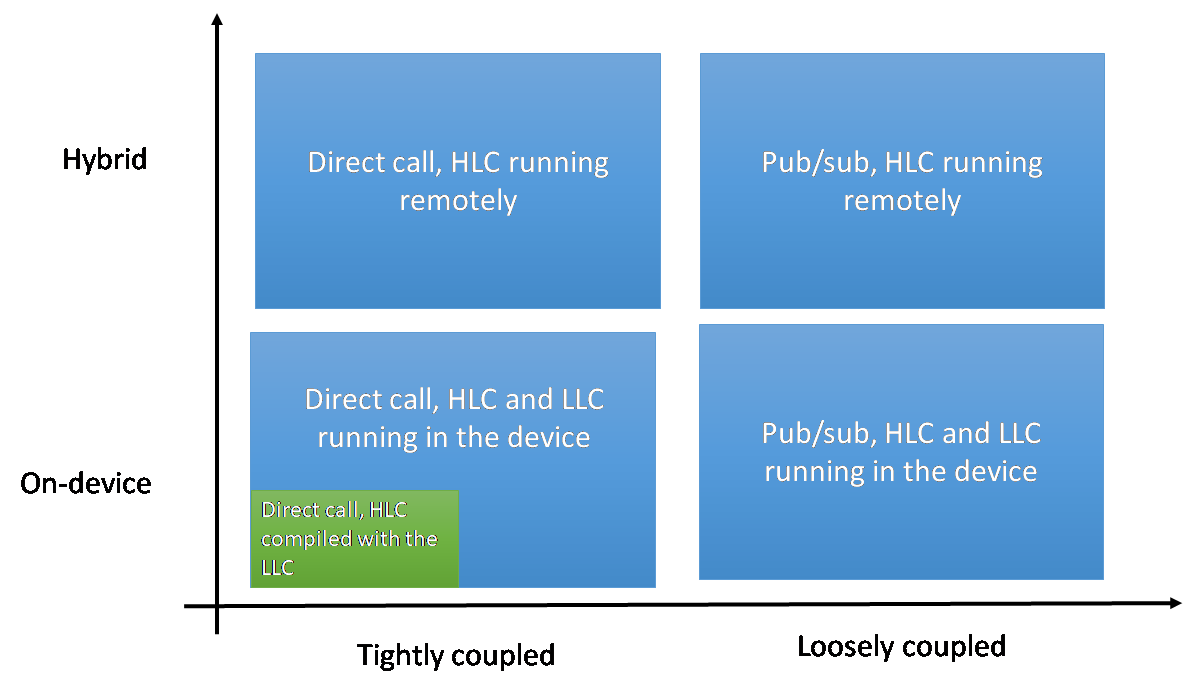
Figure SEQ Figure \* ARABIC 1: Categorisation and mapping of interface preacticies [3].
Outlook and Next Steps
At the moment, the IEEE P2660.1 WG is defining the method to select the recommended interface practice for a given application scenario, considering a collection of best interfacing practices, technologically instantiated from the identified group of templates, and their characteristics for a set of criteria that includes response time, scalability, robustness and re-usability. The establishment of these recommendation practices may contribute to mitigate the current lacks and boost the adoption of MAS and CPS-based approaches by industry.
References
- P. Leitão, Agent-based Distributed Manufacturing Control: A State-of-the-art Survey, Engineering Applications of Artificial Intelligence, vol. 22, n. 7, pp. 979-991, 2009.
- P. Leitão, S. Karnouskos, L. Ribeiro, P. Moutis, J. Barbosa, T. Strasser, “Common Practices for Integrating Industrial Agents and Low Level Automation Functions”, Proceedings of the 43th Annual Conference of the IEEE Industrial Electronics Society (IECON'17), 2017, pp. 6665-6670 (DOI: 10.1109/IECON.2017.8217164).
- P. Leitão, S. Karnouskos, L. Ribeiro, P. Moutis, J. Barbosa, T. Strasser, “Integration Patterns for Interfacing Software Agents with Industrial Automation Systems”, Proceedings of the 44th Annual Conference of the IEEE Industrial Electronics Society (IECON’18), 2018, pp. 2908-2913 (DOI: 10.1109/IECON.2018.8591641)
Contributers
 |
Paulo Leitao, IEEE Senior Member, is Professor at the Polytechnic Institute of Bragança, Portugal, and Coordinator of the Research Centre in Digitalization and Intelligent Robotics (CeDRI). His research interests are in the field of intelligent and reconfigurable systems, cyber-physical systems, Internet of Things, multi-agent systems and distributed data analysis. He participates in several national and international R&D projects, served as general chair of several international conferences, published 4 books and more than 200 papers in international scientific journals and conference proceedings. He is chairing the IEEE Standards Association P2660.1 Working Group and is the past Chair of the IEEE IES Technical Committee on Industrial Agents. |
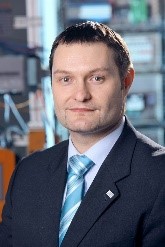 |
Thomas Strasser, IEEE Senior Member, is a Senior Scientist with the Center for Energy at the AIT Austrian Institute of Technology, Vienna, Austria. His main responsibilities involve the strategic development of smart grid automation and validation research projects where he also leads the European-funded research infrastructure project ERIGrid. Besides that, he is active as a Senior Lecturer (Privatdozent) with the Vienna University of Technology. |
9 July 2019
Detecting Traffic Event Related Posts With Traffic Related Entities
by A. Dundar Unsal, Pinar Karagoz, Hediye Tuydes-Yaman
Traffic management systems, which aim to provide measures for sustainable and optimal traffic on road network, require monitoring the traffic flow. Traffic flow is commonly monitored using sensors that are deployed on roads, such as inductive loops or camera systems . Due to high cost of installation and maintenance for such sensor systems, it is impractical to cover traffic networks with an adequate number of sensors. The information shared on social media by users or ”human sensors” as commonly referred, can complement or replace the data provided by physical sensors, as a sustainable source of data. Twitter, where 313 million active users send an average of around 500 million tweets a day, is used as a data source to evaluate the methods proposed [1][2]. Our observations show that among other topics and daily issues, tweets cover the road and traffic flow conditions, as well.
In this work, a cost effective solution to be used within traffic monitoring is proposed based on social media data, more specifically, Twitter stream. We propose a supervised learning based method, which is a type of machine learning approach that is based on developing (training/supervising) a model using manually annotated data. The proposed solution aims to classify blog posts as traffic event related or not. In order to improve the classification performance, blog posts are preprocessed by using Natural Language Processing (NLP) operations, and furthermore, traffic event related named entities are extracted by using a customized Named Entity Recognition (NER) model based on Conditional Random Fields (CRF). The case study is conducted on blog posts in Turkish, which is a morphologically complex language. This causes lower accuracy rates for Turkish texts than that of English in NLP tasks, such as NER [3]. However, working languages other than English, especially on morphologically complex languages, such as Turkish, contribute to showing the applicability of the approach in different countries.
The initial steps of the method consists of data collection, preprocessing, and morphological analysis. For data collection, we used Twitter Search API for performing queries by using a set of predefined terms to retrieve potentially relevant posts. In preprocessing step, cleaning-up, tokenization and segmentation tasks are applied. Within our method, each token is analyzed morphologically in order to extract roots and a set of inflection groups using the morphological analysis tool TRMorph [4].
Traffic event related name entity recognition and traffic event related posting classification constitutes the hearth of the method. Initally, a customized set of traffic related named entities are defined organized in entity groups such as incident related, location related or direction related named entities. For named entity recognition, we developed a model based on Conditional Random Fields (CRF), which is a supervised learning technique, which is commonly used in tag learning for sequence data. To this aim, tagging is performed on subtokens. Subtokens are represented with their surface text, morphological tags that are assigned during morphological analysis, and tag annotations. Recognized entities by the model are used as features in classification step in order to improve the accuracy performance.
In order to classify relevant posts among all tweet collection, which is optained via keyword seach using Search API, we constructed a classification model by comparing Support Vector Machines (SVM), Naive Bayes (NB) and Decision Trees based classifiers, which are commonly applied in incident detection problems.
Our data set is a tweet collection that is retrieved under location filtering defining 50mile radius around the city center of Ankara. The collection consists of 21,077 tweets, posted from January 1st to January 31st, 2017. For ground truth construction, tweets are manually annotated for the traffic entity recognition and classification. Two classes are defined to categorize the stream, Direct Traffic Report (DTR), and Other. DTR denotes that the posting is a direct and immediate report of an incident or road condition which might affect the traffic flow. On the other hand, Other denotes that the post does not meet the criteria of DTR. 649 tweets are labeled as DTR. In Figure 1, locations of some traffic events reported are shown on a map of Ankara.

Figure 1. Locations of DTR tweets around Eskişehir Road, Ankara
Feature vector corresponding to a tweet consists of stems and named entities as the feature types. Stems are the stemmed forms of the words that are generated in morphological analysis step. In order to observe the contribution of the extracted morphological features on the classification task, the experiments are conducted under different feature settings. SVM classifier performed best with the subtoken-based feature set including stems and all named entities with a F1-Score of 70.2%. SVM classifier reached this score by using the top 25% of all terms sorted by their frequency in all documents. This shows that the morphological analysis is effective for detecting traffic event related posts and all named entities contribute to the model.
Highest F1-Score of 63.9% was achieved by C4.5 algorithm-based classifier using the subtoken-based feature set consisting stems and top traffic related named entities. Classifier was able to detect 66.6% of all traffic related events, while, 61.3% of the events detected as traffic related events were actually traffic related.
Naive-Bayes classifier reached highest F1-Score of 68.1% with subtoken-based models employing stems and all entities. Models employing subtoken-based feature sets scored better in all classification tests [5].
Several challenges have been observed due to the strict inclusion criteria for DTR class. DTR label is used for only immediate and direct reports. Indirect reports of incidences that refer other sources or news articles, which do not reflect a recent incident, are labeled as Others. Such tweets affected the performance of classification task negatively, due to lack of features to model subtle semantic differences.
In this study, we aimed to investigate the effectiveness of social network postings as human sensors to be used within a traffic management system. Our observations on the Twitter data set, which is collected within the scope of this work, shows that the amount of postings on road traffic incidents and variety of the incidents covered are satisfactory to be used as sensors. The obtained results are promising to augement the physical sensors in order to monitor the road network. Furthermore, having textual content may provide additional information as to the happening, which can not be obtained through physical sensors. As a novel contribution, we particularly focus on two aspects. The first one is the use of the approach on a morphologically complex language, Turkish, on which it is harder to apply NLP than English. The performance obtained on such a language shows the applicability of the approach over a varity of languages, and hence over a varity of different countries. The second contribution is on use of traffic related named entities and the type of the named entities devised within this work. Classification of the blog posts through such named entities is shown to detect traffic related posts. Futhermore, after traffic related post detection, analysis over the named entities within the post can reveal the type of the incident, as well.
References
-
Twitter, “About Company,” 2016. [Online]. Available: http://about.twitter.com/company
-
R.Krikorian,“New Tweets per second record,and how!”, 2013.[Online]. Available: https://blog.twitter.com/2013/new-tweets-per-second-record-and-how (Visited on 22 Feb 2019)
-
G. A. Şeker and G. Eryiğit, “Initial explorations on using CRFs for Turkish named entity recognition,” In Proc. of Int. Conf. on Computational Linguistics (COLING 2012), Mumbai, India, pp. 2459–2474, 2012.
-
C. Çöltekin, “A set of open source tools for turkish natural language processing,” in Proceedings of the Ninth International Conference on Language Resources and Evaluation (LREC-2014), Reykjavik, Iceland, pp. 1079–1086, 2014.
-
A. D. Unsal, H. Tuydes-Yaman, P. Karagoz, “Event related blog post classification by using traffic related named entities”, In Proc. of Int. Smart Cities Conf. (ISC2), Kansas City, USA; Sept 16-19, 2018.
Contributers
|
A. Dundar Unsal is a PhD student in Middle East Technical University (METU) Department of Geodetic and Geographic Information Technologies. His main areas of study are Geographical Information Systems, Intelligent Transportation Systems, Information Retrieval and Natural Language Processing. He has masters degree from the same department, with a focus of Intelligent Transportation Systems. He has been working on Geographical Information Systems and other Information Systems fields in R&D companies for over 18 years. |
|
| Dr. Pinar Karagoz is working as a full professor in Middle East Technical University (METU) Computer Engineering Department. She received PhD from the same department. During her doctoral studies she worked as a researcher at SUNY Stony Brook University in New York, USA. She had research visits in MIT CSAIL in the USA, Computer Science Department of Ostrava University in Czech Republic, and Computer Engineering Department of Aalto University in Finland. Her research focuses on data mining, machine learning algorithms, information retrieval, social media analysis and mining. She has publications in internationally recognized and indexed international journals including IEEE TKDE, ACM TWEB, IEEE TII and The Computer Journal, and she has about 100 papers in international conferences in the area. In 2016 he received the best paper award in IEEE Transactions on Industrial Informatics. In 2017, her paper was nominated for a Wilkes Award of the Computer Journal. | |
| Dr. Hediye Tuydes-Yaman is a graduate of Civil Engineering (CE) Department at Middle East Technical University (METU), Ankara Turkey. She completed her MS and PhD programs in transportation at Northwestern University, IL, USA, during which she studied travel demand forecasting and network traffic modeling. Since 2006, she works a a full-time faculty member at METU, where she also currently acts as the Head of the Intelligent Transportation Systems (ITS) Unit under METU-BILTIR Research Center. She has publications in prestigious transportation and civil engineering journals, including TRR, ASCE, Accident & Analysis and Prevention, covering various topics in the fields of network management, traffic safety and ITS. She conducted various projects focused on urban transportation monitoring and management, as well as an advocacy project for on safe urban speed management funded by Global Road Safety Partnership (GRSP). More recently, she is in the executive committee of the “METU Smart Campus” project funded by the United States Trade & Development Agency (USTDA), aiming to develop a road map for the transformation of the METU Campus towards a smart and sustainable one.
|
1 August 2019
Minimum Data Sensing Enables Sustainable Digital Twins for Smart Cities
by Prof. Weisi Guo, Mr. Zhuangkun Wei, Dr. Alessio Pagani
Statement of the Challenge and Opportunity
Cities are a multiplex of both aging and smart infrastructure, both of which require precise data to enable monitoring and adaptivity. The drivers for aging infrastructure include public safety, insurance, and economic sustainability. The drivers for smart infrastructure include the above, as well as being able to provide user-centric services. In order to achieve both predictive maintenance and user-centric services, data fusion from a wide range of sensors and smart devices are required and used to inform engineering simulation models. These Digital Twins are data-driven digital models of real systems - seen as a key enabler for data-driven smart city services. In order to collect both performance and demand data across multiple infrastructures (e.g., mobility, water, electricity, telecommunication), the number of monitoring nodes is potentially enormous. This threatens the economic and environmental sustainability of digital twins both from a sensor deployment as well as from a data communication and processing perspective.
In connected systems, the underlying coupled dynamics enable us to infer the dynamics at one point from another. Across the system, this gives the complete dynamics a compressible characteristic (e.g. the dynamics from N points can be expressed as a combination of r<N points). Here we demonstrate that sparse sensing can achieve accurate inference from a small set of sensor data. Compressed Sensing (CS) [1] is a technique to optimally extract the essential data from a larger set of input data, dramatically reducing the number of sensors and amount of data at the front end. The current gaps in knowledge are as follows:
- The compression techniques such as CS often do not achieve the potential of the low rank data;
- The compressed nodes are not spatially invariant in CS approaches.
By exploiting the networked infrastructure structure, recent advances in Graph Signal Processing (GSP) [2] can potentially answer some of the above challenges. In particular, how can we efficiently compress a graph with signal dynamics and inform us of where to monitor using Internet-of-Things (IoT) enabled sensors?
Case Study: Water Distribution Network (WDN) Monitoring
Leveraging on the example of water distribution networks, failure to respond to a variety of demand and climate stressors can lead to a £40bn cost in emergency response for cities in the UK [9]. For water contamination monitoring – see Figure 1a, efforts to fully understand optimal data collection as a function of both the complex network topology and the interconnected internal transport dynamics are still limited and inaccurate. Installing an Internet-of-Things (IoT) monitoring sensor in each junction would be the obvious solution to monitor various dynamic states.
Technological Innovation
Current State-of-the-Art (SotA) in infrastructure monitoring can largely be divided into 3 distinctively different approaches:
- Engineering numerical optimisation: iterative scenario testing finds the union of all critical nodes [3]
- Graph theory: topology dominated approach enables sampling using the Laplacian [4]
- Graph signal processing: compressing networked dynamics using either data- [5] or equation-driven approaches [6].
Within the field of CS and GSP, there remains many approaches. For a matrix data X of size N x K (e.g. N is no. of nodes and K is no. of time-steps) with rank r, it has proved that, for all CS methods [2], the theoretically minimum number of samples needed is (N+K-r) x r, and a nuclear-norm based convex optimization can be used to recover X. In the context of an N node network with signal dynamics, this means for each time-step, an average of (N+K-r) x r/K sensors are used. As such, a general operator can find the minimum sample points which are dynamic over time [7,8], which is useful for power cycling sensors and saving energy in both sampling and data transmission. This has been demonstrated in water distribution networks [7,8].
Despite power cycling, the cost of sensors remain high as many are needed. As such, there are two potential challenges set out above: (1) achieve low rank r nodes for sampling, and (2) achieve spatially invariant nodes for sampling to reduce sensor deployment cost. The key innovation is to show that fixed nodes can represent the evolving dynamic of real systems, because of the underlying physics of the system.
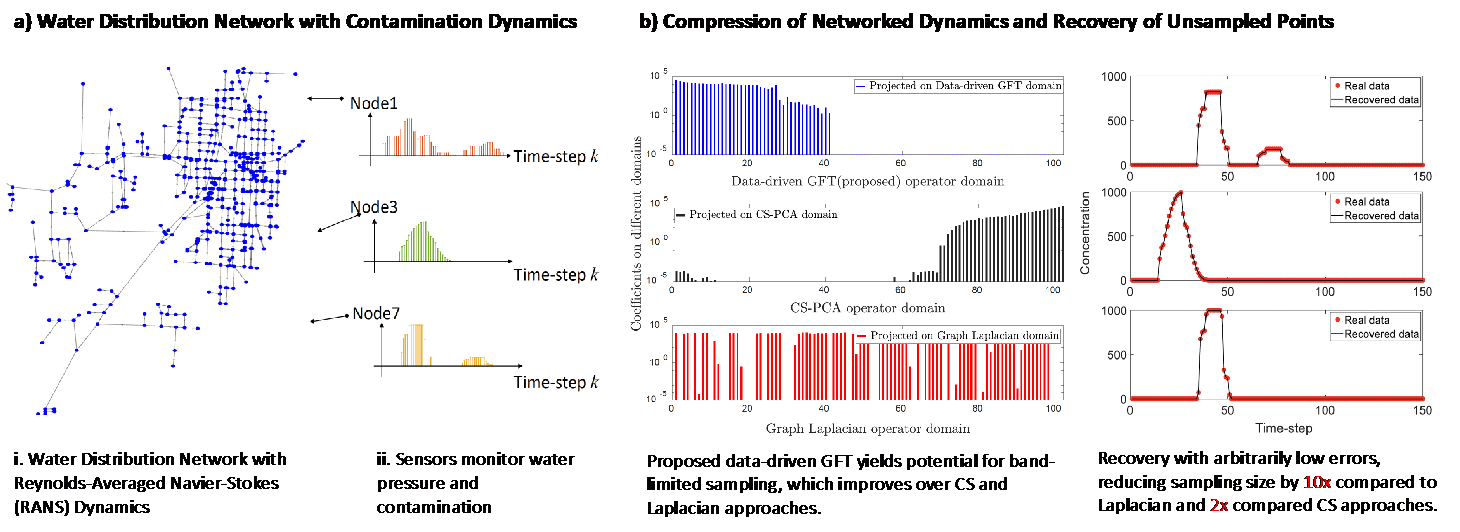 Figure 1: (a) WDN with complex topology and cascade dynamics, (b) compression of networked dynamics to find invariant bandlimited sampling points and recovery of dynamics in unsampled points.
Figure 1: (a) WDN with complex topology and cascade dynamics, (b) compression of networked dynamics to find invariant bandlimited sampling points and recovery of dynamics in unsampled points.
More recent approaches developed in Graph Fourier Transform (GFT) enables spatially invariant points to inform us of the dynamics of a network [5] – see Figure 1b. This is novel and important for achieving minimum sensors on a network, because it enables the following:
- Fixed node locations for monitoring a complex network with dynamics
- Low number of nodes for monitoring low rank dynamics
- Linear scaling with rank of the dynamics
Importance
This enables us to inform WDN operators where best to put sensors given a particular perturbation scenario. More importantly, given the high cost of WDN monitoring sensors (e.g., £160 for pH sensor, and £270 for dissolved oxygen sensor), our sparse sampling approach can reduce the cost of sensor deployment to 30% compared to deploying sensors everywhere. Within IEEE Smart Cities, this fits with a variety of functional domains (sensors, communication networks, and data analytics) and application domains (energy, water, and mobility).
Process of Deployment and Implementation
We are currently working with water distribution network (WDN) operators to try this approach of minimum sampling for a variety of UK and global WDN topologies, demand cycles, and contamination situations. We believe this data-driven approach can complement existing engineering knowledge to create significant energy and cost savings in digital twin modeling, especially in urban environments where the infrastructure density is high.
Risks and Impact
One of the risks is that the dynamics of the network change in a way that is not accounted for in our analysis. This can happen due to structural upgrades, change of operational procedure, or dramatic shift in demand patterns. Whilst this affects all sensor placement strategies, it is an unquantifiable risk that will become more apparent over time. As such, creating robust sparse sensor placement with uncertainty quantification is important. The impact of this work on future digital twin systems in smart cities will be to achieve rapid scaling without overwhelming sensors, communication, and data storage.
References
-
“Graph signal processing: Overview, challenges, and applications,” A. Ortega, P. Frossard, J. Kovacevic, J. Moura, P. Vandergheynst, Proceedings of the IEEE, 2018
-
“Multi-way Compressed Sensing for Sparse Low-Rank Tensors,” N. Sidiropoulos, A. Kyrillidis, IEEE Signal Processing Letters, 2012
-
“Sensor Placement in Municipal Water Networks,” J. Berry et al., Journal of Water Resources Planning and Management, 2005
-
“Sensor Placement in Water Distribution Networks based on Spectral Algorithms,” A. Di Nardo, C. Giudicianni, R. Greco, M. Herrera, G. Santonastaso, A. Scala, Int. Conference on Hydroinformatics, 2018
-
"Optimal Sampling of Water Distribution Network Dynamics using Graph Fourier Transform," Z. Wei, A. Pagani, G. Fu, I. Guymer, W. Chen, J. McCann, W. Guo, IEEE Transactions on Network Science and Engineering, 2019
-
"Optimal Sampling for Dynamic Complex Networks with Graph-Bandlimited Initialization," Z. Wei, B. Li, W. Guo, IEEE Access, 2019
-
"Energy Efficient Sensor Activation for Water Distribution Networks Based on Compressive Sensing," R. Du, L. Gkatzikis, L. Gkatzikis, C. Fischione, M. Xiao, IEEE Journal on Selected Areas in Communications, 2015
-
"Monitoring Networked Infrastructure with Minimum Data via Sequential Graph Fourier Transforms," Z. Wei, A. Pagani, W. Guo, IEEE International Smart Cities Conference, Morocco, Oct 2019
-
“Preparing for a drier future: England's water infrastructure needs,” UK National Infrastructure Commission, 2018.
Contributers
 |
Weisi Guo (S07, M11, SM17) received his MEng, MA, and Ph.D. degrees from the University of Cambridge. He is Chair Professor of Human Machine Intelligence at Cranfield University, and was an Ass. Prof. at University of Warwick. He is CI on EPSRC Doctoral Training Centre in Urban Science & Progress, and PI on over £2.3m of research grants from EPSRC, H2020, InnovateUK, and Royal Society. He has published over 130 papers and his research has won him awards (IET Innovation, Bell Labs Prize finalist, IEEE best paper). He is FRSS and a Turing Fellow at the Alan Turing Institute. |
 |
Zhuangkun Wei received his bachelor's degree, and master's degrees in Electronic Engineering from Beijing University of Posts and Telecommunications (BUPT), Beijing, China in 2014 and 2018 respectively. He is currently pursuing the Ph. D degree at the University of Warwick. His research interests cover molecular signals and graph signal processing. |
 |
Alessio Pagani received his bachelor's, master's, and Ph.D. degrees in electronic and computer engineering from Politecnico di Milano. He is a research fellow on the CHANCE project at the Alan Turing Institute. His current research includes the development of new methods to improve the resilience and sustainable long-term performance of man-made complex systems, helping to understand the implications of inter-dependencies within and between complex adaptive systems. |
13 November 2019
May 2021
Smart Cities - Highlights of IEEE International Smart Cities Conference 2020 (IEEE ISC2)
For a downloadable copy of this eNewsletter, please visit the IEEE Smart Cities Resource Center.
Resource Center Update: Improved user experience for IEEE members! Access/Download free products without a checkout process.
June 2021
Smart Cities - Explainable Artificial Intelligence for Smart Cities
For a downloadable copy of this eNewsletter, please visit the IEEE Smart Cities Resource Center.
Resource Center Update: Improved user experience for IEEE members! Access/Download free products without a checkout process.
July 2021
Smart Cities - July eNewsletter
For a downloadable copy of this eNewsletter, please visit the IEEE Smart Cities Resource Center.
Resource Center Update: Improved user experience for IEEE members! Access/Download free products without a checkout process.
August 2021
Smart Cities - August eNewsletter
For a downloadable copy of this eNewsletter, please visit the IEEE Smart Cities Resource Center.
Resource Center Update: Improved user experience for IEEE members! Access/Download free products without a checkout process.
September 2021
Smart Cities - September eNewsletter
For a downloadable copy of this eNewsletter, please visit the IEEE Smart Cities Resource Center.
Resource Center Update: Improved user experience for IEEE members! Access/Download free products without a checkout process.
October 2021
Smart Cities October eNewsletter - Special Issue on Smart Transportation
For a downloadable copy of this eNewsletter, please visit the IEEE Smart Cities Resource Center.
Resource Center Update: Improved user experience for IEEE members! Access/Download free products without a checkout process.
November 2021
Smart Cities November eNewsletter - Smart Transportation
For a downloadable copy of this eNewsletter, please visit the IEEE Smart Cities Resource Center.
Resource Center Update: Improved user experience for IEEE members! Access/Download free products without a checkout process.
December 2021
Smart Cities December eNewsletter - Highlights of IEEE International Smart Cities Conference 2021 (IEEE ISC2)
For a downloadable copy of this eNewsletter, please visit the IEEE Smart Cities Resource Center.
Resource Center Update: Improved user experience for IEEE members! Access/Download free products without a checkout process.
January 2022
Smart Cities January eNewsletter - Empowering Energy Citizens and Energy Communities for Smart Cities - Part 1
For a downloadable copy of this eNewsletter, please visit the IEEE Smart Cities Resource Center.
Resource Center Update: Improved user experience for IEEE members! Access/Download free products without a checkout process.
February 2022
Smart Cities February eNewsletter - Empowering Energy Citizens and Energy Communities for Smart Cities, Part 2
For a downloadable copy of this eNewsletter, please visit the IEEE Smart Cities Resource Center.
Resource Center Update: Improved user experience for IEEE members! Access/Download free products without a checkout process.
March 2022
Smart Cities March eNewsletter - Smart Energy Systems for Smart Cities
For a downloadable copy of this eNewsletter, please visit the IEEE Smart Cities Resource Center.
Resource Center Update: Improved user experience for IEEE members! Access/Download free products without a checkout process.
April 2022
Smart Cities April eNewsletter - Knowledge-Based Economy in Smart Cities
For a downloadable copy of this eNewsletter, please visit the IEEE Smart Cities Resource Center.
Resource Center Update: Improved user experience for IEEE members! Access/Download free products without a checkout process.
May 2022
Smart Cities May eNewsletter - Vehicle-to-Infrastructure Communications and EVs
For a downloadable copy of this eNewsletter, please visit the IEEE Smart Cities Resource Center.
Resource Center Update: Improved user experience for IEEE members! Access/Download free products without a checkout process.
June 2022
Smart Cities June eNewsletter - Best Practices and Development of Smart Cities Standards - Part 1
For a downloadable copy of this eNewsletter, please visit the IEEE Smart Cities Resource Center.
Resource Center Update: Improved user experience for IEEE members! Access/Download free products without a checkout process.
July 2022
Smart Cities July eNewsletter - Best Practices and Development of Smart Cities Standards - Part 2
For a downloadable copy of this eNewsletter, please visit the IEEE Smart Cities Resource Center.
Resource Center Update: Improved user experience for IEEE members! Access/Download free products without a checkout process.
August 2022
Smart Cities August eNewsletter - Resilient and Sustainable Interconnected Critical Infrastructure Systems - Part 1
For a downloadable copy of this eNewsletter, please visit the IEEE Smart Cities Resource Center.
Resource Center Update: Improved user experience for IEEE members! Access/Download free products without a checkout process.
September 2022
Smart Cities September eNewsletter - Resilient and Sustainable Interconnected Critical Infrastructure Systems - Part 2
For a downloadable copy of this eNewsletter, please visit the IEEE Smart Cities Resource Center.
Resource Center Update: Improved user experience for IEEE members! Access/Download free products without a checkout process.
October 2022
Smart Cities October eNewsletter - Communication Devices and Systems for Smart City Infrastructures
For a downloadable copy of this eNewsletter, please visit the IEEE Smart Cities Resource Center.
Resource Center Update: Improved user experience for IEEE members! Access/Download free products without a checkout process.
November 2022
Smart Cities November eNewsletter - Data Analytics for Smart Cities - Part 1
For a downloadable copy of this eNewsletter, please visit the IEEE Smart Cities Resource Center.
Resource Center Update: Improved user experience for IEEE members! Access/Download free products without a checkout process.
December 2022
Smart Cities December eNewsletter - Year in Review
For a downloadable copy of this eNewsletter, please visit the IEEE Smart Cities Resource Center.
Resource Center Update: Improved user experience for IEEE members! Access/Download free products without a checkout process.
January 2023
Smart Cities January eNewsletter - Data Analytics for Smart Cities Part 2
For a downloadable copy of this eNewsletter, please visit the IEEE Smart Cities Resource Center.
Resource Center Update: Improved user experience for IEEE members! Access/Download free products without a checkout process.
February 2023
Smart Cities February eNewsletter - General Issue
For a downloadable copy of this eNewsletter, please visit the IEEE Smart Cities Resource Center.
Resource Center Update: Improved user experience for IEEE members! Access/Download free products without a checkout process.
March 2023
Smart Cities March eNewsletter - Emerging Technology in the Development of Smart Cities in India
For a downloadable copy of this eNewsletter, please visit the IEEE Smart Cities Resource Center.
Resource Center Update: Improved user experience for IEEE members! Access/Download free products without a checkout process.
April 2023
Smart Cities April eNewsletter - Smart Cities in Extreme events
For a downloadable copy of this eNewsletter, please visit the IEEE Smart Cities Resource Center.
Resource Center Update: Improved user experience for IEEE members! Access/Download free products without a checkout process.
May 2023
Smart Cities May eNewsletter - Smart Education
For a downloadable copy of this eNewsletter, please visit the IEEE Smart Cities Resource Center.
Resource Center Update: Improved user experience for IEEE members! Access/Download free products without a checkout process.
June 2023
Smart Cities June eNewsletter - Smart Waste
For a downloadable copy of this eNewsletter, please visit the IEEE Smart Cities Resource Center.
Resource Center Update: Improved user experience for IEEE members! Access/Download free products without a checkout process.
July 2023
Smart Cities July eNewsletter - Regular Issue
For a downloadable copy of this eNewsletter, please visit the IEEE Smart Cities Resource Center.
Resource Center Update: Improved user experience for IEEE members! Access/Download free products without a checkout process.
August 2023
Smart Cities August eNewsletter - Special Issue on Aged Care
For a downloadable copy of this eNewsletter, please visit the IEEE Smart Cities Resource Center.
Resource Center Update: Improved user experience for IEEE members! Access/Download free products without a checkout process.
September 2023
Smart Cities September eNewsletter - Sustainability in Smart Cities
For a downloadable copy of this eNewsletter, please visit the IEEE Smart Cities Resource Center.
Resource Center Update: Improved user experience for IEEE members! Access/Download free products without a checkout process.
November 2023
Smart Cities November eNewsletter - Regular + Sustainability in Smart Cities - Part 2 (Hybrid)
For a downloadable copy of this eNewsletter, please visit the IEEE Smart Cities Resource Center.
Resource Center Update: Improved user experience for IEEE members! Access/Download free products without a checkout process.
January 2024
Smart Cities January eNewsletter - 2023: A Year In Review
For a downloadable copy of this eNewsletter, please visit the IEEE Smart Cities Resource Center.
Resource Center Update: Improved user experience for IEEE members! Access/Download free products without a checkout process.
February 2024
Smart Cities February eNewsletter - General Issue
For a downloadable copy of this eNewsletter, please visit the IEEE Smart Cities Resource Center.
Resource Center Update: Improved user experience for IEEE members! Access/Download free products without a checkout process.
April/May 2024
Smart Cities April/May eNewsletter - General Issue
For a downloadable copy of this eNewsletter, please visit the IEEE Smart Cities Resource Center.
Resource Center Update: Improved user experience for IEEE members! Access/Download free products without a checkout process.
Past Issues
To view archived articles, and issues, which deliver rich insight into the forces shaping the future of the smart cities. Older eNewsletter can be found here. To download full issues, visit the publications section of the IEEE Smart Cities Resource Center.

